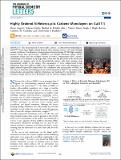Files in this item
Highly ordered N-heterocyclic carbene monolayers on Cu(111)
Item metadata
| dc.contributor.author | Angove, Eloise | |
| dc.contributor.author | Grillo, Federico | |
| dc.contributor.author | Fruchtl, Herbert A. | |
| dc.contributor.author | Veinot, Alex, J | |
| dc.contributor.author | Singh, Ishwar | |
| dc.contributor.author | Horton, J Hugh | |
| dc.contributor.author | Crudden, Cathleen M | |
| dc.contributor.author | Baddeley, Christopher J. | |
| dc.date.accessioned | 2022-05-06T11:31:03Z | |
| dc.date.available | 2022-05-06T11:31:03Z | |
| dc.date.issued | 2022-02-24 | |
| dc.identifier | 277554481 | |
| dc.identifier | 3b553f0d-daee-4415-8ed3-dc1874a65158 | |
| dc.identifier | 000766749900022 | |
| dc.identifier | 85125681622 | |
| dc.identifier.citation | Angove , E , Grillo , F , Fruchtl , H A , Veinot , A J , Singh , I , Horton , J H , Crudden , C M & Baddeley , C J 2022 , ' Highly ordered N-heterocyclic carbene monolayers on Cu(111) ' , The Journal of Physical Chemistry Letters , vol. 13 , no. 8 , pp. 2051-2056 . https://doi.org/10.1021/acs.jpclett.1c04073 | en |
| dc.identifier.issn | 1948-7185 | |
| dc.identifier.other | ORCID: /0000-0001-9961-1212/work/108914132 | |
| dc.identifier.other | ORCID: /0000-0001-6647-4266/work/108914356 | |
| dc.identifier.other | ORCID: /0000-0001-9750-6494/work/108914641 | |
| dc.identifier.uri | https://hdl.handle.net/10023/25311 | |
| dc.description | EA and FG acknowledge funding from EPSRC grants (EA: EP/R512199/1; FG: EP/S027270/1). We thank the EaStCHEM for computational support via the EaStCHEM Research Computing facility. CMC thanks the Natural Sciences and Engineering Research Council of Canada (NSERC) and the Canada Foundation for Innovation (CFI) for funding of the work from her lab described in this article. AJV acknowledges NSERC for a Vanier scholarship and the Walter C. Sumner foundation for additional financial support. IS acknowledges Queen’s University for the RT Mohan Scholarship and the Ontario government for an Ontario Graduate Scholarship. | en |
| dc.description.abstract | The benzannulated N-heterocyclic carbene, 1,3-dibenzylbenzimidazolylidene (NHCDBZ) forms large, highly ordered domains when adsorbed on Cu(111) under ultrahigh vacuum conditions. A combination of scanning tunnelling microscopy (STM), high resolution electron energy loss spectroscopy (HREELS) and density functional theory (DFT) calculations reveals that the overlayer consists of vertical benzannulated NHC moieties coordinating to Cu adatoms. Long range order results from the placement of the two benzyl substituents on opposite sides of the benzimidazole moiety, with their aromatic rings approximately parallel to the surface. The organization of three surface-bound benzyl substituents from three different NHCs into a triangular array controls the formation of a highly ordered Kagome-like surface lattice. By comparison with earlier studies of NHCs on Cu(111), we show that the binding geometry and self-assembly of NHCDBZ are influenced by intermolecular and adsorbate-substrate interactions and facilitated by the flexibility of the methylene linkage between the N-heterocycle and the aromatic wingtip substituents. | |
| dc.format.extent | 5667613 | |
| dc.language.iso | eng | |
| dc.relation.ispartof | The Journal of Physical Chemistry Letters | en |
| dc.subject | N-heterocyclic carbene | en |
| dc.subject | Scanning tunneling microscopy | en |
| dc.subject | High resolution electron energy loss spectroscopy | en |
| dc.subject | Cu | en |
| dc.subject | QD Chemistry | en |
| dc.subject | DAS | en |
| dc.subject.lcc | QD | en |
| dc.title | Highly ordered N-heterocyclic carbene monolayers on Cu(111) | en |
| dc.type | Journal article | en |
| dc.contributor.sponsor | EPSRC | en |
| dc.contributor.institution | University of St Andrews. School of Chemistry | en |
| dc.contributor.institution | University of St Andrews. EaSTCHEM | en |
| dc.identifier.doi | 10.1021/acs.jpclett.1c04073 | |
| dc.description.status | Peer reviewed | en |
| dc.identifier.grantnumber | EP/S027270/1 | en |
This item appears in the following Collection(s)
Items in the St Andrews Research Repository are protected by copyright, with all rights reserved, unless otherwise indicated.

